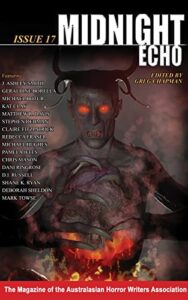Midnight Echo Volume 17: Journal of the Australasian Horror Writers Association, edited by Greg Chapman.
Australasian Horror Writers Association, July 2022
ISBN-13 : 978-0645001952
Available: Kindle, paperback. ( Bookshop.org | Amazon.com )
In his introduction, editor Greg Chapman writes, “Horror fiction, at its finest, concerns what it means to be human.” This idea is what he has built this issue around. The stories in this issue explore aspects of death, grief, memory, disability, consumption, and identity.
“La Belle Morte Sans Merci” by Kat Clay vividly describes the deterioration of a photographer obsessed with decay.
“Feathers” by Chris Mason has a very Yellow Wallpaper feel, but is told in third person, so we get to meet and like the main character while she is still sane. While there’s still tension, without the unreliable narrator, the supernatural aspect is very concrete.
In “Hand and Heart”, by Geraldine Borella, a woman with epilepsy and memory issues discovers why her mind is so muddled. This was disturbing on a personal level.
“Restless”, by D.I. Russell, is a short internal dialogue from a grieving husband who was given a disturbing gift on his retirement as a professor of anatomy. This story was tremendously sad and relatable.
In “The Fruits of Labor”, a man defeats writer’s block by consuming some very unusual fruits in the orchard behind his house that leave him wanting more. Ambition pushes him to cross the line of what is acceptable.
“Fearful Symmetry” by Stephen Dedman is a gruesome story about a lung cancer survivor with phantom pain on the right side of his body who is convinced it is trying to kill him. Dedman did a great job with the protagonist’s character development.
In “The Hole in Emily’s Heart” by MIchael Hughes, a woman has a portal into an alien dimension inside her heart where things… and people… can disappear.
“Universe, Devoured”, by Pamela Jeffs, is space horror in which a ship overrun by cannibals has only a few survivors escape, with cosmic “devourers” approaching. I wanted to cheer for the survivors from the ship,, but escaping human devourers only to face cosmic ones did not make a satisfying ending.
“Visitation Rites”, by Matthew R. Davis, is told by a child whose mother visits his father, a monster, in the cemetery each year on his birthday, to give him a photograph of his son. But after each visit, she cleans and disinfects her house, they move, and she changes their names and appearances. Who is the real monster?
“The Lighthouse”, by Claire Fitzpatrick, is from the point of view of an unreliable character, a woman who has had multiple miscarriages and unsuccessful pregnancies and is certain the house is haunted by earlier residents” mishaps during and after pregnancy, but can’t convince her husband to leave. This was an outstanding story that did not need a supernatural element to horrify, but was enhanced by its integration into the story.
“The Tub” is a cautionary story of why kids shouldn’t seek out trouble.
“Test of Death” is about a grieving friend who goes to extremes to preserve the life of a terminal cancer patient. This started out with a goodbye dinner party for the man, but the reader will soon recognize the narrator’s downward slide. The insects and body horror are vivid.
The climate horror piece “Animal Parade” has a vet attempting to save the last, nearly extinct, land animals in Australia by electrification. I found this imaginative and, unfortunately, a situation that is more horrifying because of its near-future likelihood.
There are also two poems. Rebecca Fraser’s “The House Contrition Built” really struck the mark for me. Deborah Sheldon’s “Smothered, Still, and Silent” is tense and atmospheric.
As in any collection, some stories are stronger than others, but, especially if you are trying to diversify your reading, this is a good collection to check out. Recommended.
Reviewed by Kirsten Kowalewski





Follow Us!